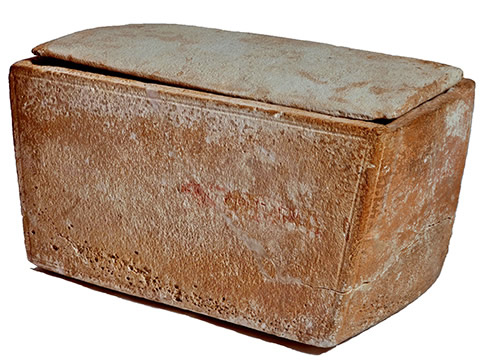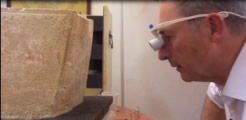The James Ossuary
The highlight of the exhibition is the James Ossuary, a first-century stone bone-box from Jerusalem attributed to James, the brother of Jesus, considered one of the most important items of biblical archaeology ever discovered.
The James Ossuary was discovered in the mid-1970s in a first-century burial cave in East Jerusalem. Extensive scientific tests conducted by dozens of researchers, research laboratories, and antiquities investigators determined that the James Ossuary and its inscription can be confidently identified as the bone-box of James, son of Joseph, brother of Jesus.



Who was James?
According to the New Testament, Jesus of Nazareth was the oldest of five brothers and two sisters (see Matthew 13:55, Mark 6:3). The second oldest was James (Ya’akov), who became one of the most important figures in the history of early Christianity.
The Apostles appointed James as head of the emerging Judeo-Christian community, leading to his role as the first Bishop of Jerusalem. Due to his personal and spiritual values he was also known as “James the Just”. Later he was canonized as St. James or Santiago. The early Christian community, which was the target of persecution, survived thanks to his leadership,
Josephus Flavius, the Roman-Jewish historian, and contemporary of Jesus and James, reported that James was stoned to death in 62 AD on the orders of the Sanhedrin. James is the author of the Book of James in the New Testament, and according to some traditions, also authored the apocryphal Gospel of James.
James in mentioned in the New Testament several times (Matthew 13, 27; Mark 6; Acts 12, 21; 1 Corinthians 5; Galatians 1, 2; James 1; Jude 1).
Scientific Tests Confirm the James Ossuary’s Authenticity
Visitors of Discovering Jesus: A Journey Back in Time will be able to review the extensive scientific tests and studies that confirm the authenticity of the inscription on the James Ossuary.


A fascinating section of the exhibition is devoted to the extensive scientific tests that were performed by the world’s most important researchers and most advanced laboratories. This testing confirmed the authenticity of the inscription on the James Ossuary and its attribution to James, son of Joseph, brother of Jesus.
The James Ossuary is now included in the Corpus Inscriptionium Ludaeae Jerusalem—the complete official corpus of inscriptions discovered in Israel.
Below is the list of world-renowned researchers and experts who examined the inscription.
Experts In Natural Sciences, Archaeometry, Microscopy, Geology, Chemistry, Stone, And Patina:
- Prof. Wolfgang Krumbein, world expert in stone, geology, bio-patina, and long-term development of micro-organisms on stone, who performed his tests in collaboration with the laboratories of Oldenburg University, Germany.
- The staff of the Israel Geological Survey of Jerusalem, which specializes in archaeometric tests. Archaeometry is the science that connects natural sciences, chemistry, geology and archeology. This included geologists Dr. Shimon Ilani and Dr. Amnon Rosenfeld, together with electronic microscope expert Michael Dvoracheck.
- Staff of the Royal Ontario Museum of Toronto, which examined the inscription before the ossuary was exhibited at the ROM in 2002.
- Orna Cohen, expert in stone and conservation for the Israel Antiquities Authority and Hebrew University of Jerusalem.
- Prof. James Harrell, of the University of Toledo, USA. Professor of geology of sediments, stone patina, and ancient construction stones.
- Prof. Yuval Goren, archeology, former staff member of the IAA and the Tel Aviv University. Expert in petrography of ancient pottery.
Experts In Archeology, Script, Language, And Engraving:
- Prof. Andre Lemaire, Sorbonne University, world expert on Semitic epigraphy, and specifically Hebrew and Aramaic inscriptions, philology, and archeology of the Land of Israel.
- Dr. Ada Yardeni, of the Hebrew University of Jerusalem, world expert in paleography, development and history of ancient Hebrew and Aramaic.
- Prof. Ronny Reich, archeologist, scholar of Jerusalem in the Second Temple period (1-2 century AD), of Haifa University, and former senior member of the Israel Antiquities Authority who participated in numerous archeological excavations in Jerusalem during the last 50 years.
- Prof. Gabriel Barkay, senior archeologist who participated in numerous archeological excavations in Jerusalem. University lecturer.
- Prof. Yosef Naveh, expert in early Hebrew and Aramaic inscriptions.
- Prof. Frank Moore Cross, of Harvard University, expert in ancient inscriptions, who examined the ossuary inscription in Canada in 2002.
- Prof. Hagai Misgav, of the Hebrew University. Expert in western Semitic inscriptions, epigraphy and paleography, and ossuary inscriptions.
- Prof. Shmuel Ahitov, biblical scholar, Ben Gurion University.
The findings of all these experts support the authenticity of the ossuary in entirety.
Prof. Camille Fuchs of Tel Aviv University and other researchers performed an extensive statistical study on the frequency of names contained in the James Ossuary inscription, and the probability that the ossuary belonged to James brother of Jesus of Nazareth. They determined that with a probability of over 99%, the ossuary was used two thousand years ago to intern the bones of James the brother of Jesus of Nazareth.
